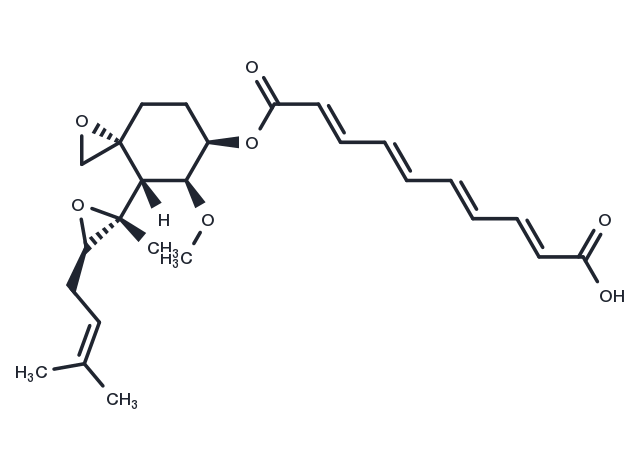Powder: -20°C for 3 years | In solvent: -80°C for 1 year


Fumagillin (Amebacilin) is a selective and potent irreversible inhibitor of Methionine aminopeptidase 2 (MetAP2), used as an antibiotic to treat microsporidiosis.

| Pack Size | Availability | Price/USD | Quantity |
|---|---|---|---|
| 1 mg | In stock | $ 52.00 | |
| 5 mg | In stock | $ 178.00 | |
| 10 mg | In stock | $ 355.00 | |
| 25 mg | In stock | $ 590.00 | |
| 50 mg | In stock | $ 859.00 | |
| 100 mg | In stock | $ 1,180.00 | |
| 500 mg | In stock | $ 2,370.00 | |
| 1 mL * 10 mM (in DMSO) | In stock | $ 182.00 |




| Description | Fumagillin (Amebacilin) is a selective and potent irreversible inhibitor of Methionine aminopeptidase 2 (MetAP2), used as an antibiotic to treat microsporidiosis. |
| In vitro | Fumagillin selectively inhibits the growth of a Δmap1 strain but not a wild-type or a Δmap2 S. cerevisiae strain missing MetAP-2. [1] In budding yeast cells, as a potent inhibitor of angiogenesis, Fumagillin not only reverses the growth inhibitory activity of Vpr, but also inhibits Vpr-dependent viral gene expression upon the infection of human macrophages. [3] Though the toxicity of fumagillin has limited its use for human applications, the analogues using structure-activity relationships relating to its angiogenesis properties may be further explored in the treatment of angiogenesis-dependent diseases. [4] |
| In vivo | In DEN-treated rats, fumagillin (30 mg/kg, i.p.) inhibits both progression of HCC in the liver itself and systemic metastasis. [2] |
| Synonyms | NSC9168, Amebacilin |
| Molecular Weight | 458.54 |
| Formula | C26H34O7 |
| CAS No. | 23110-15-8 |
Powder: -20°C for 3 years | In solvent: -80°C for 1 year
DMSO: 200.6 mM
You can also refer to dose conversion for different animals. More
bottom
Please see Inhibitor Handling Instructions for more frequently ask questions. Topics include: how to prepare stock solutions, how to store products, and cautions on cell-based assays & animal experiments, etc.
Fumagillin 23110-15-8 Microbiology/Virology Others Proteases/Proteasome HIV Protease Parasite Antibiotic inhibit NSC9168 Amebacilin NSC 9168 Human immunodeficiency virus Inhibitor HIV NSC-9168 inhibitor
